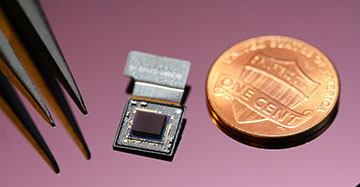
The ultrathin camera, with a U.S. one-cent coin for comparison. [Image: Ki-Hun Jeong, KAIST]
Like the compound eyes of many insects, cameras with arrays of small lenses can produce wide, sharp images. Researchers at a South Korean university have devised an extremely thin but fully packaged camera that is smaller than many coins (Light Sci. Appl, doi: 10.1038/s41377-020-0261-8).
The camera uses arrays of tiny optical elements above a planar CMOS sensor to achieve high resolution and a 73° field of view with just 740 μm of total track length, or space between the sensor and the end of the lens system. A super-resolution algorithm assembles the images from each lens channel into a single finished product.
Inspired by insects
Imaging scientists often look to the insect world for novel “compound eye” designs, and the team from the Korea Advanced Institute of Science and Technology (KAIST) is no exception. The researchers studied the eyes of males of a relatively obscure species, Xenos peckii, a parasite that uses the paper wasp as its host. The insect’s hundreds of “eyelets,” with relatively large lenses, each detect a partial, overlapping image within the creature’s field of view, providing the parasite with 50 times better spatial resolution than the conventional compound eyes of arthropods.
In a study published in 2018, the KAIST engineers demonstrated an earlier version of their parasite-inspired thin camera with a total track length of 1.4 mm. The new camera cut the track length nearly in half by inverting the arrayed microlenses to increase their refraction. Each lens had an f-number of only 1.7.
Various photolithography processes created the tiny transparent-resin arrayed lenses as well as black-resin apertures surrounding them. Tests with a 532-nm laser beam showed a lack of optical “crosstalk” between the microlenses. Actual imaging tests of patterns and small objects showed that edge sharpness increased as the number of images merged together by the software increased, as measured by modulation transfer functions.
The researchers hope that this type of ultrathin camera will lend itself to many biomedical and security-related devices and applications.
